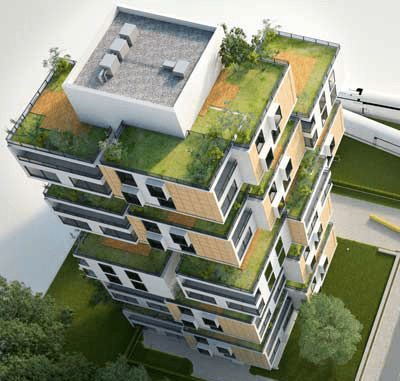Mansi Sood
Indian Institute of Technology Roorkee, Roorkee, India
Corresponding Author: mansi_s@ar.iitr.ac.in
Rajasekar Elangovan
Indian Institute of Technology Roorkee, Roorkee, India
P.S. Chani
Indian Institute of Technology Roorkee, Roorkee, India
Cite this article
Highlights
- Determination of life cycle embodied energy for a mid-rise building in the Indian context
- Comparative assessment of the determined embodied energy to existing studies and highlighting the variation in findings
- Comparative assessment of building’s envelope based on embodied energy, identifying the most and least efficient materials
Abstract
This paper addresses the estimation of a residential building’s embodied energy through real-time data and evaluates the influence of diverse infill wall materials on its embodied energy. The investigation centers on a 10storey residential structure situated in Roorkee, India’s composite climate. The study encompasses initial embodied energy from the bill of quantities and recurring embodied energy from maintenance and replacement cycles. Calculated at 11630 MJ/m², the determined lifetime embodied energy comprises 98.6% initial and 1.4% recurrent energy. A comparative analysis is conducted against existing literature and extended to alternative building envelopes. Findings indicate that using fly ash lime brick for infill walls minimizes embodied energy, potentially saving around 515MJ/m² across the building’s lifespan. This research provides valuable insights into estimating and comparing the embodied energy of residential buildings and highlights the potential energy efficiency benefits of specific building envelope choices.
Keywords
Life cycle Embodied Energy, Initial Embodied Energy, Recurrent Embodied Energy
References
- Global Alliance for Buildings and Construction, “2019 Global Status Report for Buildings and Construction,” United Nation Environment Programme, 2019, 2019.
- K. I. Praseeda, B. V. Reddy, and M. Mani, “Embodied and operational energy of urban residential buildings in India,” Energy and Buildings, vol., 110, pp. 211-219, October 2015. https://doi.org/10.1016/j.enbuild.2015.09.072
- International Finance Corporation (World Bank Group), “India Construction Materials Database of Embodied Energy and Global Warming Potential,” 2017.
- M. K. Dixit, “Life cycle recurrent embodied energy calculation of buildings: A review,” Journal of Cleaner Production, pp. 731-754, 25 October 2018. https://doi.org/10.1016/j.jclepro.2018.10.230
- A. Arabinda Debanath, S. V. Singh, and Y. P. Singh “Comparative assessment of energy requirements for different types of residential buildings in India,” Energy & Buildings, vol. 23, no. 2, pp. 141-146, May 1995. https://doi.org/10.1016/0378-7788(95)00939-6
- B. V. V. Reddy, and K. S. Jagadish “Embodied energy of common and alternative building materials and technologies,” Energy and Buildings, vol. 35, no. 2, pp. 129-137, November 2001. https://doi.org/10.1016/S0378-7788(01)00141-4
- P. Cherian, S. Palaniappan, D. Menon, and M. P. Anumolu. “Comparative study of embodied energy of affordable houses made using GFRG and conventional building technologies in India,” Energy and Buildings, vol. 223, 110138, 2020. https://doi.org/10.1016/j.enbuild.2020.110138
- R. Talakonukula, R. Prakash, and K. K. Kumar Shukla, “Life cycle energy analysis of a multifamily residential house: A case study in Indian context,” Open J. Energy Effic., vol. 2, no. 1, pp. 34-41, March 2013. https://doi.org/10.4236/ojee.2013.21006
- P. Devi, and S. Palaniappan., “A case study on life cycle energy use of residential building in Southern India,” Energy and Buildings, vol. 80, pp. 247-259, June 2014. https://doi.org/10.1016/j.enbuild.2014.05.034
- A. K. Bishnoi, R. Soumya and R. Elangovan, “Effect of Operational energy variations on life cycle energy: An evaluation in residential apartments,” in Windsor Conference, London, pp. 1102-1116, 2018.
- P.S. Chani, and R. Elangovan, “Developing an Integrated framework of green construction practices and implementation roadmap for NBCC,” NBCC, 2022.

 Bishal Thapa
Bishal Thapa





 Fred Sherman
Fred Sherman Sumedha Malaviya
Sumedha Malaviya Satish Kumar
Satish Kumar












 The three main global energy concerns of providing access to modern energy, enhancing the security of the energy supply, and minimising the impact of energy systems on the climate have an impact on both national and international energy governance. To develop solutions that address the many facets of these difficulties, however, a variety of actors and stakeholders must be included due to the complexity of the energy challenges.
The three main global energy concerns of providing access to modern energy, enhancing the security of the energy supply, and minimising the impact of energy systems on the climate have an impact on both national and international energy governance. To develop solutions that address the many facets of these difficulties, however, a variety of actors and stakeholders must be included due to the complexity of the energy challenges. Cities are responsible for more than 70% of the world’s energy consumption and 40% to 50% of its greenhouse gas emissions. Managing increasing urbanisation is a challenge, and nations must deal with the effects it will have on the environment in terms of energy and climate.
Cities are responsible for more than 70% of the world’s energy consumption and 40% to 50% of its greenhouse gas emissions. Managing increasing urbanisation is a challenge, and nations must deal with the effects it will have on the environment in terms of energy and climate. Our transition to a future with lower carbon emissions depends heavily on buildings. They are our places of residence, rest, and employment; they also account for around one-third of the world’s greenhouse gas emissions and nearly 40% of the world’s energy usage.
Our transition to a future with lower carbon emissions depends heavily on buildings. They are our places of residence, rest, and employment; they also account for around one-third of the world’s greenhouse gas emissions and nearly 40% of the world’s energy usage.